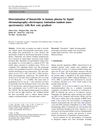
Search
for
Sort by
Research
90-120 / 222 results

research Role of Liposomal Drug-Delivery System in Cosmetics
Liposomes improve the delivery and effectiveness of cosmetic ingredients but face challenges like cost and stability.

research Topical Finasteride for the Treatment of Male Androgenetic Alopecia and Female Pattern Hair Loss: A Review of the Current Literature
Topical finasteride helps regrow hair and reduce hair loss in men and women.

research Nanocarrier Systems for Transdermal Drug Delivery
Nanocarriers could improve how drugs are delivered through the skin but require more research to overcome challenges and ensure safety.

research Novel Iron Oxide Nanocarriers Loading Finasteride or Dutasteride: Enhanced Skin Penetration for Topical Treatment of Alopecia
Iron oxide nanoparticles improve skin penetration and drug release for hair loss treatment.

research Development and Ex-Vivo Skin Permeation Studies of Finasteride–Poly(Lactic Acid-Co-Glycolic Acid) and Minoxidil–Chitosan Nanoparticulate Systems
Nanoparticles show potential for controlled release of hair loss drugs, improving treatment effectiveness.

research Coenzyme Q10 Phospholipidic Vesicular Formulations for Treatment of Androgenic Alopecia: Ex Vivo Permeation and Clinical Appraisal
Coenzyme Q10 vesicular formulations can potentially treat androgenic alopecia by promoting hair growth and thickness.

research Transfollicular Drug Delivery: Current Perspectives
Transfollicular drug delivery is promising but needs more research to improve and understand it better.

research Trends in Nanotechnology for Practical Applications
Nanotechnology is improving drug delivery and targeting, with promising applications in cancer treatment, gene therapy, and cosmetics, but challenges remain in ensuring precise delivery and safety.

research Squarticles as Nanoantidotes to Sequester Overdosed Antidepressants for Detoxification
Tiny particles called anionic squarticles can effectively remove a common antidepressant from the body after an overdose.

research Penetration Profile and Human Cadaver Skin Distribution of Finasteride from Vesicular Nanocarriers
Ethosomal carriers effectively deliver hair loss drug into skin.

research Nanoporous Silica Entrapped Lipid-Drug Complexes for the Solubilization and Absorption Enhancement of Poorly Soluble Drugs
Nanoporous silica entrapped lipid-drug complexes significantly improve the solubility and absorption of drugs that don't dissolve well in water.

research A Review: Pharmacological Activities of Quinoline Alkaloids of Cinchona Species
Quinoline alkaloids from Cinchona may help treat cancer, diabetes, fungal infections, and promote hair growth.

research Development and Evaluation of Finasteride-Loaded Ethosomes for Targeting the Pilosebaceous Unit
Finasteride-loaded ethosomes improve hair loss treatment by targeting pilosebaceous unit.

research New Treatments for Hair Loss
Several new treatments for different types of hair loss show promise in improving patient quality of life.

research Genotoxicity of Rice Bran Oil Extracted by Supercritical CO2 Extraction
Rice bran oil extracted by supercritical CO2 is considered non-genotoxic.

research Invasomes: Vesicles for Enhanced Skin Delivery of Drugs
Invasomes effectively deliver drugs through the skin and have potential for improved treatments.

research Mechanistic Study of Decreased Skin Penetration Using a Combination of Sonophoresis with Sodium Fluorescein-Loaded PEGylated Liposomes with D-Limonene
Using sonophoresis can make it harder for certain drug-loaded liposomes to get through the skin.

research Skin Deposition and Permeation of Finasteride In Vitro: Effects of Propylene Glycol, Ethanol, and Sodium Lauryl Sulfate
Propylene glycol and ethanol increase finasteride skin absorption, sodium lauryl sulfate doesn't.

research Hair Follicle Targeting with Nanoparticles
Nanoparticles can be used to deliver drugs to hair follicles, potentially improving treatments for conditions like acne and alopecia, and could also be used for vaccine delivery and gene therapy.

research Determination of Permeation Pathway of Gentamicin into Pig's Ear Skin
Gentamicin penetrates pig skin better through open hair follicles than blocked ones.

research Optimization of Minoxidil Microemulsions Using Fractional Factorial Design Approach
The study found a way to improve a skin-applied minoxidil formula using a specific design method.

research Telogen Effluvium: Comprehensive Overview and Treatment
Telogen Effluvium is a hair loss condition where treatment involves identifying and managing its triggers.

research Acute Dermal and Ocular Irritation Testing of Rice Bran Supercritical CO2 Extract (RB-SCE) and 0.5% RB-SCE Essence Product
Rice bran extract caused moderate skin irritation but no eye irritation, while a diluted essence was not irritating to skin and only slightly to guinea pigs.

research The Novel Excipient, Dodecyl-2-N, N-Dimethylaminopropionate Hydrochloride (DDAIP-HCl) Improves the Flux of Minoxidil in Human Skin
DDAIP-HCl significantly increases minoxidil absorption into the skin.

research Determination of Finasteride in Human Plasma by Liquid Chromatography-Electrospray Ionization Tandem Mass Spectrometry with Flow Rate Gradient
Researchers developed a quick and sensitive way to measure finasteride in blood using a small sample size.

research Cosmeceuticals: The Bioactive Elements in New-Age Beauty Products
Cosmeceuticals are popular for their skin health benefits and anti-aging effects.

research Review on Seasonal Incidence of Psoriasis Exacerbations During Winter in India: Clinical Insights and Observations
Psoriasis worsens in winter in India due to less sunlight and dry skin, needing personalized treatment.

research Pilose Antler Extracts Promote Hair Growth in Androgenetic Alopecia Mice by Activating Hair Follicle Stem Cells via the AKT and Wnt Pathways
Pilose antler extracts help hair growth by activating hair follicle stem cells.

research Larvicidal Potential, Antimicrobial Properties and Molecular Docking Analysis of Egyptian Mint (Mentha Rotundifolia) Against Culex Pipiens L. (Diptera: Culicidae) and Midgut-Borne Staphylococcus Aureus
Egyptian Mint effectively kills mosquito larvae and inhibits certain bacteria.